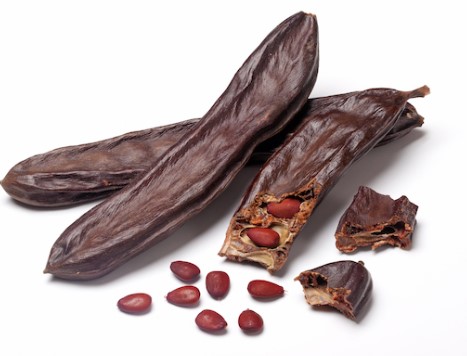I understand you’d love to share a bar of chocolate with your doggo, but can dogs eat chocolate?
The short answer is no. And if you have a bit of time, grab some chocolate (for yourself, of course) to snack on while we go through the main reasons why chocolate is dangerous for dogs, toxicity levels, the symptoms and risks of chocolate poisoning, and more.
Can Dogs Eat Chocolate: Table of Contents
Can Dogs Eat Chocolate?
No. This tasty candy can be toxic to your dog. Chocolate is made from grounded and roasted cacao seed kernels. It contains high levels of theobromine and some caffeine, both toxic to dogs and can cause potentially life-threatening conditions.
Both theobromine and caffeine are methylxanthines – chemicals that can significantly damage dogs’ central nervous and cardiovascular systems.
Theobromine, in particular, is the more potent and dangerous of the two. But the caffeine alone can still be problematic for our four-legged friends.
Dogs metabolize theobromine and caffeine more slowly than humans, allowing them to build up in their systems to toxic levels.
Plus, chocolates are packed with sugar and preservatives; so even more concern is added to these irresistible human treats.
Another important thing about toxicity levels is that smaller dogs are more likely to experience chocolate poisoning than bigger dogs, even if they eat the same amount of chocolate.
Understanding Toxicity Levels
While not every type of chocolate is the same and differs in the amount of theobromine and caffeine, every kind of chocolate is dangerous for dogs.
| Chocolate type | Mg(milligrams) of theobromine per ounce/gram of chocolate |
| Cocoa powder | ~390 |
| Baking chocolate | ~290 |
| Dark chocolate | ~130 |
| Milk chocolate | ~51 |
| White chocolate | ~0.25 |
Here’s a quick breakdown:
- Cocoa powder: The most dangerous way for a dog to get chocolate poisoning as it contains the highest possible levels of theobromine and often leads to life-threatening situations.
- Baking chocolate: This type of chocolate is extremely dangerous for dogs, as it has dangerously high the highest theobromine level.
- Dark Chocolate: Contains high theobromine levels. Even a tiny amount can be dangerous for dogs and cause serious health problems.
- Milk Chocolate: While less toxic than dark chocolate, it can still pose a significant risk, especially if consumed in large quantities.
- White Chocolate: Contains the least theobromine and caffeine. But it’s best not to give it to dogs, as it can still lead to digestive issues.
The following table shows the minimum amount of theobromine in the minimum amount of chocolate that dogs would have to eat to get chocolate poisoning, based on their size (weight):
| Dog’s size (weight) | Amount of chocolate (e.g. dark chocolate) | Amount of theobromine |
| 70lbs (31.75 kg) | 1.4 oz (40 g) | ~182 mg |
| 50lbs (22.68 kg) | 1 oz (28 g) | ~130 mg |
| 30lbs (13.6 kg) | 0.6 oz (17 g) | ~78 mg |
| 15lbs (6.8 kg) | 0.3 oz (8.5 g) | ~39 mg |
10 Most Common Symptoms of Chocolate Poisoning
If you’re not sure whether your dog ate some chocolate or not, try to see if there are any of the following symptoms:
Low level:
- Panting
- Fast breathing
- Increased heart rate
- Hyperactivity
Medium level:
- Vomiting
- Diarrhea
- Shaking/trembling
High level (life-threatening signs):
- High body-temperature
- Excessive urination
- Fainting (often leading to death)
If you observe any of these symptoms, contact your veterinarian immediately. The severity of the symptoms will depend on the type and amount of chocolate consumed, as well as your dog’s size and sensitivity.
5 Most Common Risks of Chocolate Poisoning
Let’s quickly go through some of the most common health problems that can happen if your doggo eats chocolate.
- Long-term digestive problems: Digestive issues are the most common consequence if your dog eats chocolate. Since their system can’t process chocolate ingredients, your dog will most likely have trouble digesting the food for a shorter or even extended period.
- Restlessness: Your dog might becomestart becoming anxious and restless, similar to having caffeine overdose, but much more intense.
- Seizures: The more chocolate your dog consumes, the higher chance there will be a seizure, which can be fatal in some cases.
- Extreme thirst: Due to symptoms such as high body temperature and excessive urination, it’s common for a dog to be extremely thirsty during chocolate poisoning.
- Collapse: In the most extreme cases of chocolate poisoning, a dog can collapse, a sign of a life-threatening situation. Although an intervention from a vet could help, this could lead to the worst-case scenario – death.
Myths About Dogs and Chocolate
There are many misconceptions about dogs and chocolate; knowing about them can save a dog’s life.
Small Amounts of Chocolate Are Safe
This is a dangerous assumption. While a small amount of chocolate might not be fatal, even a small piece of dark chocolate can be toxic to a tiny dog – remember, the toxicity level varies with the dog’s size.
White Chocolate Is Harmless
While white chocolate contains less theobromine, it’s still unsafe for dogs. It can cause gastrointestinal distress and discomfort, so it’s best to avoid it altogether.
Some Dogs Can Tolerate Chocolate
Every dog’s tolerance level is different, and it’s impossible to predict how an individual dog will react to chocolate. It’s not worth the risk.
Inducing Vomiting Will Solve the Problem
Inducing vomiting in a dog who has ingested chocolate can be risky and may not fully eliminate the toxins from their system.
What Should I Do If My Dog Eats Chocolate?
If you see your dog ate chocolate, contact your vet immediately. The sooner you seek professional help, the better the chances of preventing (or dealing with) the chocolate poisoning.
What Is the Treatment For Chocolate Poisoning?
It’s important to understand that a veterinarian’s intervention is the only safe way to treat chocolate poisoning in dogs. The treatment process depends on the level of intoxication and the dog’s symptoms.
Usually, the chocolate poisoning treatment follows:
- Inducing vomiting by injection of apomorphine
- Giving the dog anti-nausea medication
- Using ECG to monitor the heart rate and check for signs of arrhythmia. If signs show up, the dog gets medications for lowering the heart rate. If there are no signs of heart-rate problems, the vet gives the dog a drug called ‘’activated charcoal’’ which prevents the system from re-cycling and re-absorbing the toxins.
- The dog will most likely be hospitalized for observation, and further treatment includes IV fluids.
Chocolate: Nutritional Chart
| Chocolate (dark/classic) 100 gr | Nutritive values in grams |
| Total fat | 31 g |
| Saturated fat | 19 g |
| Trans fat regulation | 0.1 g |
| Cholesterol | 0.008 g |
| Sodium | 0.024 g |
| Potassium | 0.559 g |
| Total carbohydrate | 61g |
| Dietary fiber | 7 g |
| Sugar | 48 g |
| Protein | 4.9 g |
| Caffeine | 0.043 g |
| Iron | 44% |
| Calcium | 5% |
| Magnesium | 36% |
| Cobalamin | 3% |
| Total calories | 546 |
Ideas for Dog-Friendly Chocolate Alternatives
Yes, I know – it’d be unfair to enjoy chocolate treats while our four-legged friends can only watch. This is why some brands offer dog-friendly “chocolate”- carob-based treats.
If you want to enjoy some chocolate with your pup, here are some alternatives to check out:
- Puppuccino by Starbucks
- Party-mix chocolate bones by Frankie Loves Bakery
- Cookies with carob chips by Three Dog Bakery
What Is Carob?

Carob is a three that carries its fruit in a form of seed pods, similar to chocolate. People ground up the seeds to make carob powder, just like cocoa powder. It’s similar to chocolate in many aspects, including the look, texture, nutrition, taste, etc.
Why Are Carob-Based Treats Safe For Dogs?
It’s simple – carob doesn’t contain caffeine or the deadly, poisonous, very toxic theobromine that chocolate contains. Even though it’s similar to chocolate and many people consider it chocolate’s substitute, it’s safe for dogs.
Peanut Butter and Carob Dog Treat: Recipe
If you’re wondering about a recipe for dogs that could replace chocolate, the good news is – there are. Here are the ingredients and instructions you’ll need to make carob-based treats for your pup:
Ingredients:
- 1 cup carob powder
- 2 cups whole wheat flour
- 1/2 cup rolled oats
- 1/4 cup peanut butter (unsalted, no added sugar)
- 1/4 cup unsweetened applesauce
- 1/4 cup water
- 1 egg
- 1 teaspoon vanilla extract
Pro tip: Avoid using sugar and use ingredients without added sugar or sweeteners.
Instructions:
- Preheat your oven to 350°F (175°C) and line a baking sheet with parchment paper.
- Combine the carob powder, whole wheat flour, and rolled oats in a large mixing bowl. Mix them well, ensuring there are no lumps.
- Melt the peanut butter in a separate microwave-safe bowl for about 20-30 seconds until it’s easier to work with. Be careful not to overheat it.
- Add the melted peanut butter, unsweetened applesauce, water, egg, and vanilla extract to the dry ingredients in the large mixing bowl.
- Mix everything until you have a firm dough. You may need to use your hands to knead the dough and fully incorporate all the ingredients.
- On a floured surface, roll out the dough to a thickness of about half a centimeter (1/4 inch).
- Use dog-themed cookie cutters or any shape you prefer to cut out the treats. Place them on the prepared baking sheet, leaving a little space between each one.
- Bake in the oven for 20-25 minutes or until the treats are firm and slightly browned.
- Remove the treats from the oven and cool on a wire rack. They will become harder as they cool.
- Once completely cooled, store the carob-based dog treats in an airtight container for up to two weeks. Your furry friend will love these homemade treats as an occasional snack.
Prevention Is the Key
The best way to deal with chocolate and dogs is to prevent the problem in the first place. Here are some tips to prevent your dog from eating chocolate and keep them safe:
- Store chocolate securely: Keep all chocolate products out of your dog’s reach. Dogs are crafty and can sniff out chocolate even when it’s well hidden.
- Inform your family and friends: To avoid accidental chocolate poisoning, ensure everyone in your household and visitors knows how toxic chocolate is for dogs.
- Always keep a close eye on your dog during meals: If you don’t have a yard and your dog is spending most of the time inside, be sure to check on your pup, especially during holiday meals (it’s more likely that some chocolate-based food or snack will end up on the ground during that time)
My Senior Paws is a participant in the Amazon Services LLC Associates Program, an affiliate advertising program designed to provide a means for sites to earn advertising fees by advertising and linking to Amazon.com. We also participate in other affiliate programs which compensate us for referring traffic.




